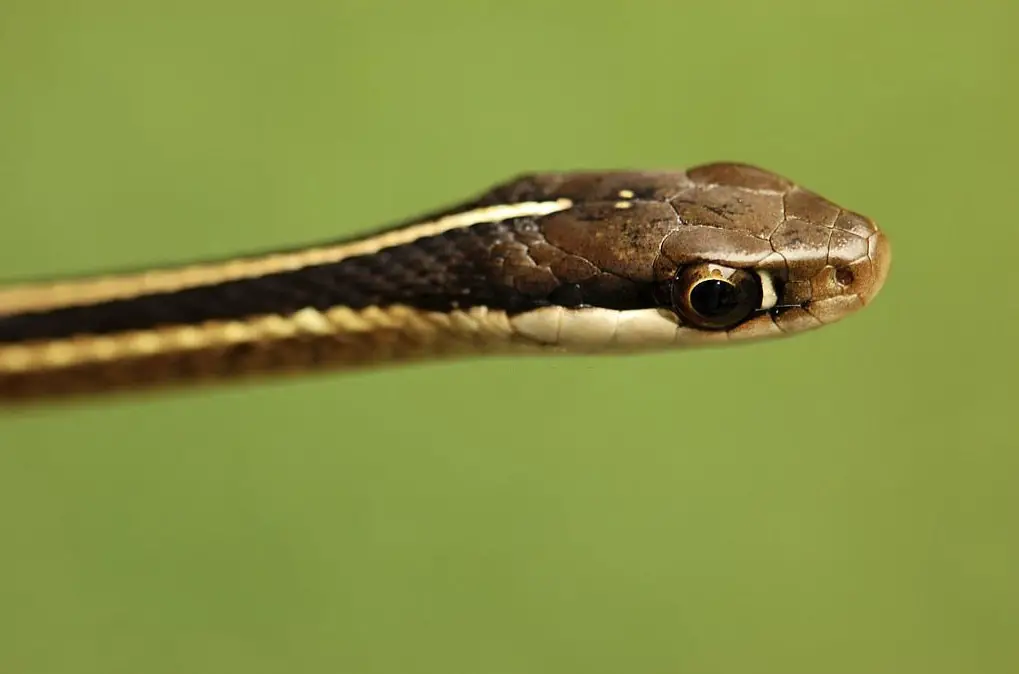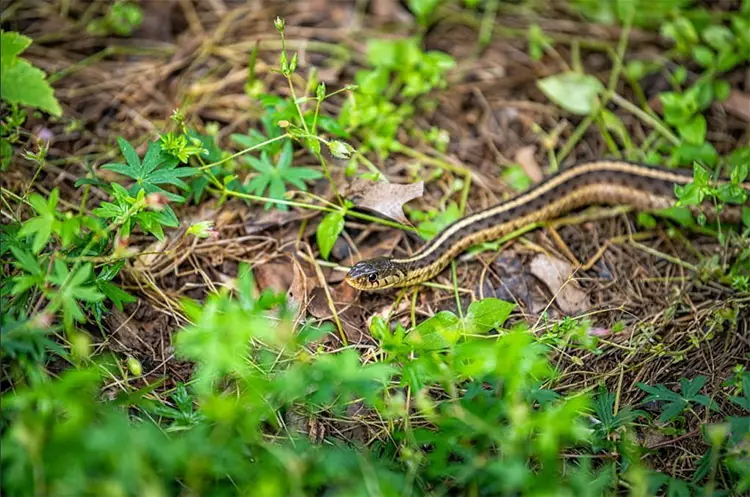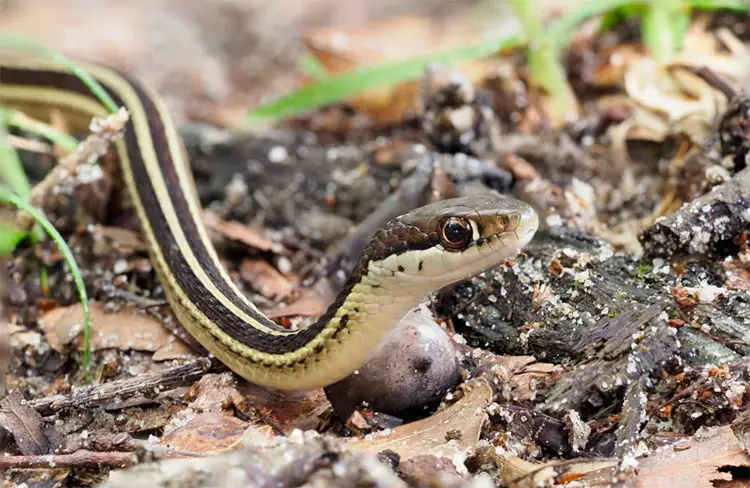If you’ve never heard of a ribbon snake before, you’re not alone. This species of a garter snake is often overlooked in the reptile trade, being kept and loved most often by hobbyists that live in the areas surrounding its natural habitats.
Despite its lack in popularity among the worldwide reptile hobby, ribbon snakes can prove to be one of the most fun and easy-to-care for snakes around.
In today’s care guide, we’re going in-depth on ribbon snakes. We’re going to discuss their enclosures, diets, temperaments, and general care.
| Common Name: | Ribbon Snake |
| Scientific Name: | Thamnophis saurita |
| Natural Habitat: | North America |
| Adult Size: | 1-2’ |
| Lifespan: | 11 years |
| Diet: | Carnivore |
| Experience Level: | Beginner |
| Enclosure Size: | 2.5’ x 1’ x 1’ |
Overview
The ribbon snake (Thamnophis saurita) is a non-venomous snake that’s native to the Eastern portion of North America. They make their homes in fields, forests, and other open areas, but can also be found alongside rivers and in wetlands, as they are a semi-aquatic species.
These snakes stay relatively small and manageable, requiring basic care which includes temperatures between 75 and 85 degrees, low to moderate humidity levels, and an appropriately sized enclosure with plenty of enrichment and things to explore.
Ribbon snakes do best on a diet of cold-blooded prey items such as frogs, lizards, tadpoles, fish, earthworms, and crickets. They can also be fed small mice.
Ribbon snakes are peaceful and slow to defend themselves with aggression, favoring escaping over confrontation. With regular handling, they can be incredibly docile.
Enclosure
Size
Ribbon snakes are small snakes, but that doesn’t mean that they deserve small enclosures. In fact, it’s best to provide your ribbon snake with the largest enclosure possible.
However, if space is a luxury, your ribbon snake could survive and even thrive in a 20 to 30-gallon aquarium. Baby ribbon snakes can live in a 5-gallon enclosure when they are first born, but will need to be upgraded to a larger enclosure as they mature.
Humidity
Like most species of garter snakes, ribbon snakes need humidity levels of between 35 and 60 percent. Levels that are higher or lower than this range on a regular basis can cause sickness and distress in your ribbon snake.
Keep in mind, though, that it’s acceptable for humidity to be higher on the cooler end of the enclosure and lower on the hotter end. It may also be higher at night.
To raise humidity levels, you can mist your snake’s enclosure as needed. If you can’t raise the levels within the entire enclosure, you might consider raising the humidity of a small area instead.
To achieve this, you could provide your snake with a humidity box, which is a container or hide that’s filled with damp sphagnum moss and has only one small entrance. Your snake can go in and out of the hide as they see fit. If you opt for this route, be sure to change the moss occasionally, as to avoid mold growth and bacteria build-up.
Galápagos Terrarium Sphagnum Moss
Temperature
As humans, our body temperature is automatically regulated since we are warm-blooded. Snakes, on the other hand, are cold-blooded, which means that they rely on the temperature of their surroundings to regulate their body temperature.
This makes it necessary for ribbon snakes to be able to move between areas of different temperatures as they see fit. Your ribbon snake enclosure should have a temperature gradient, going from cold to warm and ending in a hot spot, which is a space in the enclosure that is noticeably warmer than the other areas.
The cool side of your ribbon snake’s enclosure should be somewhere between 75 and 80 degrees Fahrenheit and the warm side 85 to 90 degrees Fahrenheit.
It’s important to note that general air temperatures (the cool side temperatures are considered the “general air temperatures”) of above 91 degrees are dangerous, possibly resulting in heat stroke, stress, or death.
At night, temperatures can drop a few degrees below 75 to recreate the cooler nights of our snake’s natural habitat. During the winter, daytime temperatures can sit at the lower end of the recommended general range.
To achieve adequate temperatures, you can opt to use heat bulbs, ceramic heat emitters, or under-the-tank heating (UTH) options such as heat tape or heat pads. Alternatively, you can also use radiant heat panels (RHP), which attach to the side or top of your enclosure (on the inside) and radiant heat into it.
VIVOSUN Reptile Heat Mat with Digital Thermostat
Depending on how large your snake’s enclosure is, you may need more than one heat source to achieve the desired temperature. In either case, be sure to connect your heat sources to a thermostat to ensure that your snake doesn’t get too hot or too cold.
You may be wondering about heat rocks; are they suitable for ribbon snakes?
The answer is no! Heat rocks are dangerous for all reptiles including ribbon snakes because of their tendency to overheat and cause burns even when they are on a thermostat.

Enrichment
Plants/foliage
The addition of plants and Foliage can elevate the look (and coziness) of your snake’s enclosure. Most species of snakes enjoy an enclosure that is full of greenery and plants, whether they’re real or artificial.
In your enclosure, you can use either type — or a combination of both, if you choose.
Finn’s Forest Manzanita Driftwood
Artificial plants come in a seemingly endless number of varieties that range in color, shape, size, and material. Some are soft and silky, while others are rigid and ideal for snakes to climb on. When using artificial plants, just be sure that the selected plants don’t have any sharp edges or jagged
Hides
Hides are an important component of creating an adequate ribbon snake enclosure. Hides are crucial for your snake feeling safe and happy, and each enclosure should have at least two — one on the cool side of the enclosure and one on the warm side.
Hides can include everything from commercially made rock caves and reptile hideouts to plastic containers with doorways cut out of them.
Diet
Snakes are carnivorous — and the ribbon snake is no exception. When in captivity, ribbon snakes eat small prey items such as guppies, minnows, and small goldfish. They can also be fed crickets, grasshoppers, tadpoles, and earthworms of varying sizes. A variety of food should be offered to ensure that the snake’s nutritional needs are being met.
To mix their diet up, occasionally offer small mice or frogs.
Some sources recommend offering live food as an occasional treat, but it’s best to avoid offering live food as it can be hard to get snakes eating FT (frozen thawed) diets after they’ve been allowed to eat live prey.
Ribbon snakes have hearty appetites — more so than most other species of snakes, so they should be fed more often on average. The recommendation is two to three small meals a week.
How much they need to eat to stay alive, though, can be estimated based on their age. Hatchlings should eat every 3-5 days and juveniles and adults every 4-7 days.
The size of your snake’s meal items should be no larger than 1.5x the width of the thickest part of their body. Due to caloric density, snakes that are fed primarily worms may not need to be fed as often. When offering fish or worms, more than one prey item can be offered in a single feeding session.
Food items for ribbon snakes can include:
- Guppies
- Plates
- Mice
- Earthworms
- Crickets
- Button quail
- Tadpoles
- Small lizards
Snakes don’t need vitamin or mineral supplements but giving them some occasionally doesn’t hurt. In fact, it’s a good way to help prevent nutrient deficiencies and health issues.
Once a week, dust your snake’s prey with a mix of calcium and multivitamin before thawing. Then, be sure not to wipe it off or thaw the item in water, which would wash it off.
In addition, ribbon snakes should always have a source of fresh water to drink. They appreciate their water sources being large enough to swim in, if possible.
Handling and Behavior
The ribbon snake is easy to tame, tends to like human attention and interaction, and can be handled without fear of the snake being provoked to bite or becoming agitated. This may not – and often is not – the case for wild-caught ribbon snakes, as they have not been socialized and are going to be fearful and defensive, which leads to biting.
When a ribbon snake doesn’t wish to be held, he or she will try to wiggle out of your grip and make themselves very hard to catch. When your snake displays this behavior, do not grab their tail or try to force them into being handled unless it’s necessary for cage cleaning or veterinary care.
Ribbon snakes are incredibly intelligent and can slither out of even the most secure habitats, so it’s vital that your aquarium or terrarium has a tight-fitting lid with no spaces large enough for the snake to escape through.
If you’re bringing a new ribbon snake home, it’s best to wait for a while before you attempt to start handling — in new surroundings, even the tamest of ribbon snakes can feel fearful. This often takes one to two weeks, which is also around the same time that snakes often start eating for new owners.
Once the snake has eaten and is ready to be handled, start by taking it slow. Opt for brief handling sessions of no more than 5 minutes each. If your snake is fearful or seems unsure, only return it to its enclosure once it has calmed down and no longer perceives you as a direct threat in that instance. This will, over time, train the snake’s brain to associate you with safety instead of danger.

Gradually increase the length of your sessions until you reach a length that works well for you and your snake. You’ll want to handle your snake at least once a week, but no more than once per day. A balance of somewhere within this range will keep your snake social and well-versed in human interaction while also avoiding stressing it out.
Always be gentle while handling your snake. If you can, avoid grabbing it. Lift from below rather than above when possible, and support as much of its body as you can. This is important with every species of snake, but ribbon snakes won’t cling to your hands and fingers the way constrictors do, which means that it’s up to you to support and hold onto them sufficiently even as they wiggle and slither.
Breeding
Even if you aren’t intending for it to, keeping a male and female ribbon snake together can lead to breeding. Most of the time, there’s nothing that you need to do to encourage this process. If both snakes are healthy and of breeding age, it will happen without any intervention. Before keeping a male and female together, be sure that you’re prepared to handle the hatchlings should they breed.
If you breed them, you’ll need an enclosure set up like your main enclosure — this is for the hatchlings.
Females give birth to anywhere from 2-26 live young, usually during the summer months.
Ribbon Snake FAQs
No! Ribbon snakes have large, healthy populations in their natural regions.
Although they enjoy swimming, ribbon snakes do not typically soak in water. When a snake exhibits this behavior, it’s often indicative of mites.
They aren’t venomous and won’t poison you if you’re bitten, but ribbon snake bites can definitely be painful and uncomfortable.
Ribbon snakes are friendly and docile. Of course, however, this can be dependent on the individual snake, where it came from, and how often it’s handled.
Other similar snakes:





